Introduction
Orthodontic treatment usually involves wearing of braces (removable or fixed) to improve the appearance of your teeth and face as well as the function. Since your brace treatment usually takes a long time to complete, you will need to pay extra attention on oral hygiene at home. This is to avoid tooth decay and gum disease caused by accumulation of dental plaque. In addition diet control during your orthodontic treatment is also important in the maintenance of your dental health.
Why Is It Important To Keep Your Teeth And Braces Clean?
Food particles and plaque tend to collect more readily around your braces; making regular cleaning more difficult. The removable braces can be removed for cleaning whereas fixed braces are attached to your teeth and cannot be removed for cleaning. Poor cleaning often leads to swollen gums and early tooth decay.
Swollen and bleeding gums are an indication of gum inflammation caused by build-up of plaque. Although gum inflammation is known to improve after braces are removed, around 10% of orthodontic patients have significant loss of gum attachment to teeth which is irreversible (Zachrisson, 1976).
Early tooth decay show up as white marks (white spot lesions) on your tooth surface due to acid challenge from bacteria in plaque. Gorelick et al (1982) found that, 50% of brace wearers had white spot lesions on their tooth surfaces compared with only 25% of non-wearers. Meticulous cleaning of teeth and braces will help reverse this disease process if addressed early. Otherwise, these white marks may progress to become caries and your teeth will be cavitated.
Orthodontic treatment would be meaningless if there is damage to your teeth and gums at the end of treatment, due to neglect of oral hygiene.
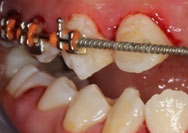 |
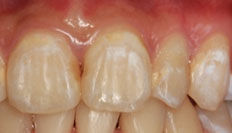 |
|
|
Gum inflammation due to plaque build-up next to the gum margins |
|
White marks (early decay) and caries following treatment with fixed braces |
What Are The Home Care Measures You Have To Take If You Wear Braces?
- If you wear fixed braces, you will need to spend more time when cleaning your teeth. Brush thoroughly between your brackets and around the gums with a suitable toothbrush and toothpaste. The use of an interdental brush or dental floss will help to clean between the teeth, around the brackets and underneath the wires. Ideally, you ought to brush your teeth after each meal and most importantly before going to bed.
Apart from brushing, a fluoride mouth-rinse (0.05% sodium fluoride), if used daily, will help protect your teeth from damage (Benson P.E.et al, 2005). The presence of fluoride in the environment results in the formation of “fluorapatite” in the surface layer of the tooth, causing arrest of the white spot lesion and inhibiting further damage (Chang et al, 1997).
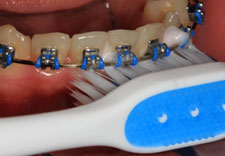
Toothbrush should reach area near the gum margin
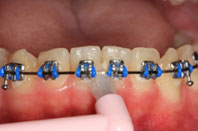
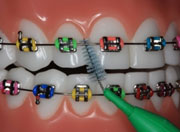
End tufted brush or interdental brush used to clean between brackets
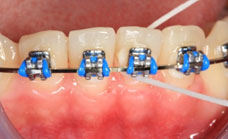
Dental floss used to clean difficult to reach areas
- If you are wearing removable braces or retainers, they should be removed for cleaning. You can clean the removable brace with a toothbrush which is not too hard. You may also use a suitable retainer cleaning product or denture cleaner which helps in removing the hard deposits (calculus) as well as in keeping your removable brace smelling fresh always.
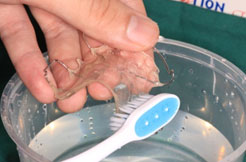
Your removable brace should be cleaned thoroughly using a toothbrush

Soak your brace (20 mins) in a bowl containing retainer cleaning tablet dissolved in water, then rinse thoroughly before use
- Avoid eating hard foods such as sweets, crusty bread or nuts and sticky food such as toffee and chewing gum, as these may damage your braces. You should also avoid fizzy drinks during your treatment as acid in these drinks will erode the tooth surface and cause thinning of the enamel layer. Frequent intake of sugary food or drinks between your meals should also be avoided to minimise the acid challenge in your mouth (Yip et al, 2009).
- Contact your orthodontist if your brace breaks or becomes loose so that an emergency appointment can be arranged. You should remember that repeated breakages will slow down your treatment. Your orthodontist will also advise you to use some soft wax on parts of the braces which are rubbing against your cheeks or lips in order to prevent ulcers in these areas.
When you decide to have orthodontic treatment with braces, keeping your mouth clean and healthy throughout the treatment is very important. By paying extra attention to home care, you can avoid serious damage to your teeth and gums; when the orthodontic treatment is completed, you will have a beautiful and healthy smile that can last a lifetime!
References
- Zachrisson, BU. (1976). Cause and prevention of injuries to teeth and supporting structures during orthodontic treatment. American Journal of Orthodontics, 69, 285-300.
- Gorelick, L., Geiger, A.M., Gwinnett, A.J.(1982). Incidence of white spot formation after bonding and banding. American Journal of Orthodontics, 81, 93–8.
- Andersson, R., Arvidsson, E., Crossner, C.G, Holm A.K., Mansson, B., Grahnen, H. (1974).The flow rate, pH and buffer effect of mixed saliva in children. J Int Assoc Dent Child, 5, 5-12.
- Benson, P.E., Shah, A.A., Millett, D.T., Dyer, F., Parkin, N., Vine, R.S. (2005). Fluorides, orthodontics and demineralization: a systematic review. Journal of Orthodontics, 32,102-114.
- Chang, H. S., Walsh, L.J., Freer, T.J. (1997). Enamel demineralization during orthodontic treatment: Aetiology and prevention. Australian Dental Journal, 42(5), 322- 7.
- Yip, H.H.Y., Wong, R.W.K., Hägg, U., (2009). Complications of orthodontic treatment: Are soft drinks a risk factor? World Journal of Orthodontics, 10, 33-40.
| Last Reviewed | : | 28 August 2020 |
| Writer | : | Dr. Surguna Devi a/p R.S. Muniandy |
| Accreditor | : | Dr. Goh Ai Hwa |
| Reviewer | : | Dr, Hjh Rashidah bt. Dato’ Hj. Burhanuddin |







